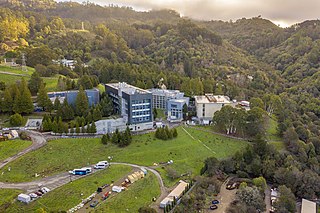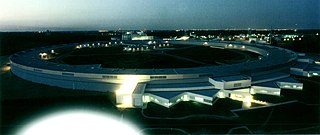
Lawrence Berkeley National Laboratory (LBNL) is a federally funded research and development center in the hills of Berkeley, California, United States. Established in 1931 by the University of California (UC), the laboratory is sponsored by the United States Department of Energy and administrated by the UC system. Ernest Lawrence, who won the Nobel prize for inventing the cyclotron, founded the Lab and served as its Director until his death in 1958. Located in the hills of Berkeley, California, the lab overlooks the campus of the University of California, Berkeley.

Argonne National Laboratory is a federally funded research and development center in Lemont, Illinois, United States. Founded in 1946, the laboratory is owned by the United States Department of Energy and administered by UChicago Argonne LLC of the University of Chicago. The facility is the largest national laboratory in the Midwest.

The Advanced Photon Source (APS) at Argonne National Laboratory is a storage-ring-based high-energy X-ray light source facility. It is one of five X-ray light sources owned and funded by the U.S. Department of Energy Office of Science. The APS began operation on March 26, 1995. It is operated as a user facility, meaning that it is open to the world’s scientific community, and more than 5,500 researchers make use of its resources each year.
The Center for Nanophase Materials Sciences is the first of the five Nanoscale Science Research Centers sponsored by the United States Department of Energy. It is located in Oak Ridge, Tennessee and is a collaborative research facility for the synthesis, characterization, theory/ modeling/ simulation, and design of nanoscale materials. It is co-located with Spallation Neutron Source.

The United States Department of Energy National Laboratories and Technology Centers is a system of laboratories overseen by the United States Department of Energy (DOE) for scientific and technological research. The primary mission of the DOE national laboratories is to conduct research and development (R&D) addressing national priorities: energy and climate, the environment, national security, and health. Sixteen of the seventeen DOE national laboratories are federally funded research and development centers administered, managed, operated and staffed by private-sector organizations under management and operating (M&O) contracts with the DOE.
The Center for Functional Nanomaterials (CFN) is a science laboratory specializing in nanoscale research. It is located at the Brookhaven National Laboratory on Long Island, New York, United States.

The National High Magnetic Field Laboratory (MagLab) is a facility at Florida State University, the University of Florida, and Los Alamos National Laboratory in New Mexico, that performs magnetic field research in physics, biology, bioengineering, chemistry, geochemistry, biochemistry. It is the only such facility in the US, and is among twelve high magnetic facilities worldwide. The lab is supported by the National Science Foundation and the state of Florida, and works in collaboration with private industry.

The hard X-ray nanoprobe at the Center for Nanoscale Materials (CNM), Argonne National Lab advanced the state of the art by providing a hard X-ray microscopy beamline with the highest spatial resolution in the world. It provides for fluorescence, diffraction, and transmission imaging with hard X-rays at a spatial resolution of 30 nm or better. A dedicated source, beamline, and optics form the basis for these capabilities. This unique instrument is not only key to the specific research areas of the CNM; it will also be a general utility, available to the broader nanoscience community in studying nanomaterials and nanostructures, particularly for embedded structures.

The Advanced Light Source (ALS) is a research facility at Lawrence Berkeley National Laboratory in Berkeley, California. One of the world's brightest sources of ultraviolet and soft x-ray light, the ALS is the first "third-generation" synchrotron light source in its energy range, providing multiple extremely bright sources of intense and coherent short-wavelength light for use in scientific experiments by researchers from around the world. It is funded by the US Department of Energy (DOE) and operated by the University of California. In June 2018, Stephen Kevan became the director of the ALS.
Joachim Stöhr is a physicist and professor emeritus of the Photon Science Department of Stanford University. His research has focused on the development of X-ray and synchrotron radiation techniques and their applications in different scientific fields with emphasis on surface science and magnetism. During his career he also held several scientific leadership positions, such as the director of the Stanford Synchrotron Radiation Laboratory (SSRL) and he was the founding director of the Linac Coherent Light Source (LCLS), the world's first x-ray free electron laser.
The Office of Science is a component of the United States Department of Energy (DOE). The Office of Science is the lead federal agency supporting fundamental scientific research for energy and the Nation’s largest supporter of basic research in the physical sciences. The Office of Science portfolio has two principal thrusts: direct support of scientific research and direct support of the development, construction, and operation of unique, open-access scientific user facilities that are made available for use by external researchers.

The Environmental Molecular Sciences Laboratory is a Department of Energy, Office of Science facility at Pacific Northwest National Laboratory in Richland, Washington, United States.

The Istituto Italiano di Tecnologia (IIT) (in English: Italian Institute of Technology) is a scientific research centre based in Genoa (Italy, EU). Its main goal is the advancement of science, in Italy and worldwide, through projects and discoveries oriented to applications and technology. Some account IIT as the best Italian scientific research centre.
The Argonne–Northwestern Solar Energy Research Center is a joint research program between the Argonne National Laboratory and Northwestern University. Michael R. Wasielewski, Professor of Chemistry at Northwestern founded the ANSER center in 2007 and is its current director. The center's goal is to develop the fundamental understanding, materials, and methods necessary to create efficient and economically viable technologies for solar fuels and electricity production. The union of synthesis, measurement, theory, and engineering allows ANSER to create exceptional new energy conversion systems. As part of its $777 million effort to establish Energy Frontier Research Centers, Grants provided by the US Department of Energy will enable the ANSER "to analyse photosynthesis for ways to create more efficient photovoltaic cells and create hybrid solar cells that have both organic and inorganic components."
The Center for Probing the Nanoscale (CPN) at Stanford University was founded in 2004 by researchers from Stanford University and IBM. The center is one of the National Science Foundation (NSF) Nanoscale Science and Engineering Centers (NSEC). The goal of the center is to develop and apply novel nanoprobes that dramatically improve our capability to observe, manipulate, and control nanoscale objects and phenomena. Developed technology will be transferred to industry for commercial implementation. Nanoprobe development and applications are under way in five theme groups, focusing on Individual Nanomagnet Characterization, Nanoscale Magnetic Resonance Imaging, Nanoscale Electrical Imaging, Plasmonic Scanning Tunneling Microscopy and BioProbes.

The Los Alamos Neutron Science Center (LANSCE), formerly known as the Los Alamos Meson Physics Facility (LAMPF), is one of the world's most powerful linear accelerators. It is located in Los Alamos National Laboratory in New Mexico in Technical Area 53. It was the most powerful linear accelerator in the world when it was opened in June 1972. The technology used in the accelerator was developed under the direction of nuclear physicist Louis Rosen. The facility is capable of accelerating protons up to 800 MeV. Multiple beamlines allow for a variety of experiments to be run at once, and the facility is used for many types of research in materials testing and neutron science. It is also used for medical radioisotope production.

The National Synchrotron Light Source II (NSLS-II) at Brookhaven National Laboratory (BNL) in Upton, New York is a national user research facility funded primarily by the U.S. Department of Energy's (DOE) Office of Science. NSLS-II is one of the world's most advanced synchrotron light sources, designed to produce x-rays 10,000 times brighter than BNL's original light source, the National Synchrotron Light Source (NSLS). NSLS-II supports basic and applied research in energy security, advanced materials synthesis and manufacturing, environment, and human health.
Mark Beno was a Senior Chemist at the Argonne National Laboratory best known for his work in chemical crystallography. He was the first to determine the crystal structure of the high temperature superconductor, YBa2Cu3O7, and his research continues to help researchers understand the types and structures that are likely to form this class. Beno was posthumously awarded the distinction of Fellow by the American Association for the Advancement of Science (AAAS).
The National User Facilities are a set of large-scale scientific facilities maintained by the U.S. Department of Energy, Office of Science, whose roles are to provide the scientific community with world-leading scientific instruments to enable research. These facilities are generally free to use, and are open to scientists from all over the world, usually through the submission and evaluation of research proposals.

Ilke Arslan is a Turkish American microscopist who is Director of the Center for Nanoscale Materials and the Nanoscience and Technology division at Argonne National Laboratory. She was awarded the Presidential Early Career Award for Scientists and Engineers in 2010 and appointed to the Oppenheimer Science and Energy Leadership Program in 2020.












